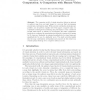Free Online Productivity Tools
i2Speak
i2Symbol
i2OCR
iTex2Img
iWeb2Print
iWeb2Shot
i2Type
iPdf2Split
iPdf2Merge
i2Bopomofo
i2Arabic
i2Style
i2Image
i2PDF
iLatex2Rtf
Sci2ools
IWINAC
2007
Springer
2007
Springer
Optimal Cue Combination for Saliency Computation: A Comparison with Human Vision
The computer model of visual attention derives an interest or saliency map from an input image in a process that encompasses several data combination steps. While several combination strategies are possible, not all perform equally well. This paper compares main cue combination strategies by measuring the performance of the considered models with respect to human eye movements. Six main combination methods are compared in experiments involving the viewing of 40 images by 20 observers. Similarity is evaluated qualitatively by visual tests and quantitatively by use of a similarity score. The study provides insight into the map combination mechanisms and proposes in this respect an overall optimal strategy for a computer saliency model.
| Added | 08 Jun 2010 |
| Updated | 08 Jun 2010 |
| Type | Conference |
| Year | 2007 |
| Where | IWINAC |
| Authors | Alexandre Bur, Heinz Hügli |
Comments (0)

